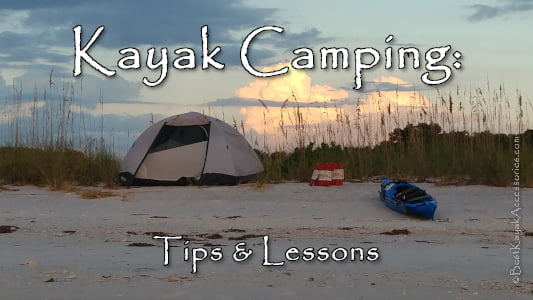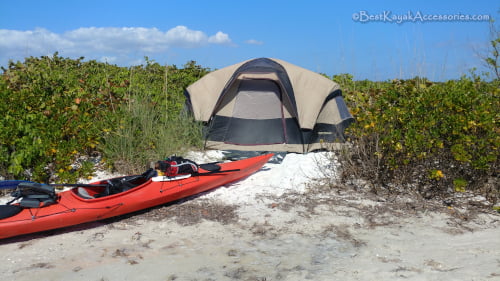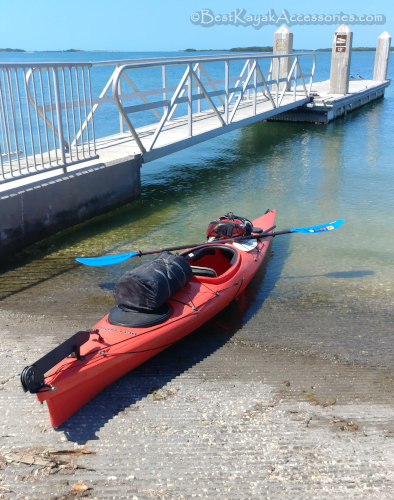AKA – Things I learned on my first Kayak Camping Trip.

A few months ago, I went on my first kayak camping trip to Shell Key (Map & Info). I grew up camping with my family in RV parks, so I kind of knew what I was doing. The trip was only going to be gone one night, and camp was only a mile and a half from the boat ramp. I was mainly camping so I could have a peaceful night where I didn’t have to drive home but could enjoy 2 days exploring the islands and enjoy the water.
See also: Shell Key Trips
Since I had to pack everything in my kayak, and didn’t plan to be at camp very much, I packed pretty light. So what did I learn on this trip, and what would I recommend to you as you consider your first kayak camping trip?
Plan your supplies in advance:
A backpacking checklist is pretty comparable to what you will want for your overnight kayak trip. I did OK here, and don’t feel like I forgot much of what I’d need.
- Tent or hammock
- Sleeping bag, pad, and pillow
- Food and water
- Light
- Cooking, dishes, etc.
- First aid kit
- Emergency boat repair items
- Dry bags
- Your regular kayak equipment for conditions
Make sure everything fits in your kayak before you go on your kayak camping trip:
You want as much in your dry hatches and under the deck as possible. Weight above the deck will make your kayak less stable. Try to center heavy items as much as possible. Smaller bags and packages are easier to pack than larger bags. This was one area that I definitely could have improved. I got all of my items to camp, but I was thankful that it wasn’t a very long paddle to my campsite.
Test out any new gear:
Did you purchase new gear for this trip? Make sure that it works as you expect it to before you get out on the water or to your campsite. This is another area that you’ll see in the lessons learned section.
Have a map, a float plan, and backup batteries/power
This should go without saying, but let people know where you’ll be and when. You don’t want to get lost, and you want people to know where to find you in case of emergency.

Lessons learned on my kayak camping trip:
- Use backpacking equipment instead of regular camping equipment.
- I assumed most sleeping bags were similar in size, but mine ended up taking up most of my rear hatch. This greatly reduced my under deck storage capacity.
- My tent was about 15 lbs. and was too long to fit in the hatch, and as I said my sleeping bag took up most of that space anyways. I ended up putting it on my rear deck. It ended up being fine there, but having this much weight above deck made the kayak less stable, and I worried a few times that I may capsize.
- Backpacking equipment packs down much smaller and is lighter.
- The ground is a lot harder than you normally think after a long day of paddling. I had my sleeping bag, but forgot to bring a pillow. Normally, I can sleep anywhere, even on the floor. After paddling all day, though, I was tired and a little sore. The ground didn’t feel as nice and I was wishing I had brought a pillow this night.
- Test your gear. This is where I really could have done better. Knowing my cell phone battery lasts about a day, I knew I’d need to recharge. I didn’t want to spend a lot of money on a power bank, and I wanted one that might be good for longer trips. I found solar powered power banks, and that sounded like a good plan. Unfortunately, the one I got wouldn’t charge my phone fast enough, so I had no phone on the 2nd day of my trip. This seems to be a common issue with most solar power banks.
- Have multiple lights. I had a light on my phone and a light on the power bank, so I should be covered, right? Unfortunately neither of these ended up working. The phone because the battery was dead, and the power bank – who knows? (See test your gear above, but it had worked at the house). Luckily there was a full moon and I met some friendly neighbors that I hung out with.
- Plan your food wisely. So I was only going to be gone 1 night, and to save space, I wasn’t bringing a cooler. I got a sandwich from the grocery store for day 1, and I planned to eat PB&J sandwiches and protein bars for the evening day 1 and during the day on day 2. The grocery store sandwich was a good plan, and PB&J was fine. I just got hungrier than I expected from paddling so much (about 16.5 miles total) and I got tired of PB&J and protein bars pretty fast.
New Gear for Next Kayak Camping Trip
Having learned some lessons and planning to go kayak camping again soon, I decided to invest in some new gear. I’ll share with you what I decided on and why, but I haven’t been out with it yet. I’ll post a followup to let you know how it worked after I have another overnight kayak camping trip.
- Tent: Kelty Gunnison 4 (Shop Now) I picked this up, because it was lightweight, and it packs down smaller than my last tent. The last tent was too long to go through the hatch opening in the kayak, and I didn’t like it riding on the deck. The awning feature looked awesome (I did get trekking poles to set the awning up). I also like that the tent has 2 doors. It comes in several different sizes, and I chose the 4 person. Another nice thing about the tent is that it includes the footprint. I also picked up the Kelty Gear Loft (Shop Now) to keep things organized inside.
- Sleeping Bag: ALPS Dash 35 (Shop Similar) I think this was on a closeout, but the Aura is similar. I liked it because it packs down quite a bit smaller than my previous sleeping bag. The compression stuff sack also helps to keep the pack as small as possible. There are several different temperature ratings available, but 35 is fine for where I am in FL.
- Sleeping Pad: Klymit Inertia X Frame Recon (Shop Now) I haven’t used a sleeping pad in the past. This seemed to be a small, lightweight, affordable option to try out and see if it helps improve my sleep. I haven’t slept on it yet, but it was easy to inflate and repack.
- Pillow: NEMO Fillo (Shop Now) I’m excited about this one. It comes with it’s own stuff sack to pack very small. It has memory foam over an inflatable bladder, so it is very comfortable like a pillow while saving a lot of space. I’ve used this already as a test, and it was very comfortable.
- Sleep Alternative: Kammok Roo Double (Shop Now) w/ Python Straps (Shop Now) Although Shell Key doesn’t have trees, a hammock seemed like a great option for other places I may camp, and it packs down way smaller than the tent. I didn’t shop too hard for the straps. I chose the Python straps, because they were made by the same company as the hammock.
- Light: BioLite Headlamp 330 (Shop Now) The people I met on my trip used headlamps, and it was very convenient and they lasted a long time. I wanted something rechargeable. This wasn’t the cheapest, but it had great reviews and most of the cheaper ones were either non-rechargeable or they had spotty reviews. I ended up spending a little extra on this one, and in the short tests I’ve done, it works well. Very comfortable, many different brightness settings, and easy to use. I’m excited to see if it meets expectations on a trip.
- Cooler: IceMule Classic 10L (Shop Now) I wanted a soft sided cooler that could fit more easily through a hatch. Coolers were an item with a lot of options, prices that varied wildly, and differing reviews. I decided on the IceMule, because it was consistently highly rated, but wasn’t the most expensive. This is another one that I’m excited to test on a longer trip and see if it lives up to my high expectations.
- Dry Bags: Freegrace Set of 3 (Shop Now) This isn’t our highest rated bag, but I like the idea of zip seal plus roll top closure to keep the bag extra dry. I figured I’d give it a try and add to our ratings and reviews. I just needed a basic bag too, so while I like the purge valves and compression features on some of the other dry bags, I didn’t need it for this particular use.
- Charging solution: Ridgid USB Phone Charger (Shop Now) This is probably the most unique solution. After looking over a lot of the solar chargers, it seemed that most of them charge very slowly by solar. That is the main reason for me getting one of those power banks. I have Ridgid power tools, and happened to see this USB charger. I know the Ridgid batteries hold their charges while not in use, so I’m thinking this will work well. The batteries are heavy, which is the only downside I see. If you use other brands, they may have a charger like this too.
I also have a new kayak that I picked up, but not specifically for camping. It’s a Wilderness Systems Tsunami 140 (Shop Now). That’s all I’ve added for now. I plan to add a single burner stove and try to get more adventurous with my meals in the future. I will get back to you on my thoughts after using these things on an actual overnight trip along with any new lessons I pick up along the way.
What lessons have you learned while kayak camping?



